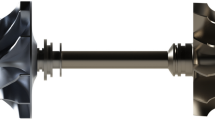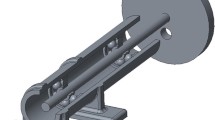Abstract
The purpose of this study is to investigate the optimal design of rotors with respect to different objective functions. The dynamic behavior of a rotating system is strongly influenced by various parameters such as mass and stiffness distribution, rigid disk inertial properties, bearing locations and coefficients. To a greater or lesser extent, all bearings are flexible and all bearings absorb energy. Moreover, load deflection relationships are often a function of shaft speed. An optimal design can be achieved by minimizing a selected target function subjected to specific constraints within a set of reasonable bounds for inner and outer diameters of the different stations, stiffness and damping coefficients of the support bearings and their positions. Optimal design of rotors has been reported by many authors in the literature. However, all of these optimization analyses considered beam elements instead of solid elements to the best knowledge of the authors. Nowadays three-dimensional models of rotors are common practice in the industry. Therefore solid models of rotating systems are considered in the current work. Stability criteria, critical speeds, weight, real and complex eigenfrequencies, and unbalance responses may be defined as a set of objective functions and constraints. In order to judge the stability, the equivalent damping ratio is evaluated. The determination of the damped critical speeds is accomplished using a Campbell diagram, a plot of damped natural whirl frequencies versus spin speeds, which is generated by determining the natural frequencies over a range of rotational speeds. A mode-tracking procedure is implemented in order to sort the complex eigenvalues. The complete finite element analysis including the complex design optimization problem of the rotor system at hand is conducted in PERMAS. For this purpose several optimization algorithms are available. Furthermore gradient-based and derivative free methods can be used. A combined shape and sizing optimization is used to illustrate the procedure by means of an example taken from the literature.
Access this chapter
Tax calculation will be finalised at checkout
Purchases are for personal use only
Similar content being viewed by others
References
PERMAS Product Description. http://www.intes.de/kategorie_unternehmen/publikationen
Wagner N, Helfrich R (2014) Useful tools in the design process of rotor-bearing systems. NAFEMS Nordic Conference, Gothenburg, Sweden, 13–14 May 2014
Wang JH, Shih FW (1990) Improve the stability of rotor subjected to fluid leakage by optimum diameters design. J Vib Acoust 112:59–64
Chen TY, Wang BP (1993) Optimum design of rotor-bearing systems with eigenvalue constraints. J Eng Gas Turbines Power 11:256–260
Lopez RH, Ritto TG, Sampaio R, Souza de Cursi JE (2014) A new algorithm for the robust optimization of rotor-bearing systems. Eng Opt 46:1123–1138
Ritto T, Lopez RH, Sampaio R, Souza de Cursi JE (2010) Optimization of a flexible rotor-bearing system considering uncertainties. In: Proceedings of PACAM XI, Foz do Iguacu, PR, Brazil
Lin Y, Cheng L, Huang TP (1998) Optimal design of complex flexible rotor-support systems using minimum strain energy under multi-constraint conditions. J Sound Vib 215:1123–1134
Lin YH, Lin SC (2001) Optimal weight design of rotor systems with oil-film bearings subjected to frequency constraints. Finite Elem Anal Des 37:777–798
Pugachev A (2013) Application of gradient-based optimization methods for a rotor system with static stress, natural frequency, and harmonic response constraints. Struct Multi Optim 47:951–962
Shiau TN, Hwang JL (1990) Optimum weight design of a rotor bearing system with dynamic behavior constraints. J Eng Gas Turbines Power 112:454–462
Lee DS, Choi DH (2000) Reduced weight design of a flexible rotor with ball bearing stiffness characteristics varying with rotational speed and load. J Vib Acoust 122:203–208
Rajan M, Rajan SD, Nelson HD, Chen WJ (1987) Optimal placement of critical speeds in rotor-bearing systems. J Vib Acoust Stress Reliab Des 109:152–157
Huang SC, Lin CA (2002) Sensitivity analysis and optimization of undamped rotor-critical speeds to supports stiffness. J Vib Acoust 126:296–301
Shiau TN, Chang JR (1993) Multi-objective optimization of rotor-bearing system with critical speed constraints. J Eng Gas Turbines Power 115:246–255
Angantyr A, Aidanpää JO (2006) Constrained optimization of gas turbine tilting pad bearing designs. J Eng Gas Turbines Power 128:873–878
Choi BG (2001) Multi-objective optimum design of rotor-bearing systems with dynamic constraints using immune-genetic algorithm. J Eng Gas Turbines Power 123:78–81
Angantyr A, Aidanpää JO (2004) A Pareto-based genetic algorithm search approach to handle damped natural frequency constraints in turbo generator rotor system design. J Eng Gas Turbines Power 126:619–625
Choi BG, Yang BS (2000) Optimum shape design of rotor shafts using genetic algorithm. J Vib Control 6:207–222
Untaroiu CD, Untaroiu A (2010) Constrained design optimization of rotor-tilting pad bearing systems. J Eng Gas Turbines Power 132(12):122502
Yang BS, Choi SP, Kim YC (2005) Vibration reduction optimum design of a steam-turbine rotor-bearing system using a hybrid genetic algorithm. Struct Multi Optim 30:43–53
Angantyr A, Aidanpää JO (2004) Optimization of a rotor-bearing system with an evolutionary algorithm. The 10th international symposium on transport phenomena and dynamics of rotating machinery, Honolulu, Hawaii, 07–11 March 2004
Cole MOT, Wongratamaphisan T, Keogh PS (2006) On LMI-based optimization of vibration and stability in rotor system design. J Eng Gas Turbines Power 128:677–684
Marazzi M, Nocedal J (2002) Wedge trust region methods for derivative free optimization. Math Program Ser A 91:289–305
Koroishi EH, de Cavalini AA, Lima AMG, Steffen V (2012) Stochastic modeling of flexible rotors. J Braz Soc Mech Sci Eng 34:574–583
Stocki R, Szolc T, Tauzowski P, Knabel J (2012) Robust design optimization of the vibrating rotor shaft system subjected to selected dynamic constraints. Mech Syst Signal Process 29:34–44
Author information
Authors and Affiliations
Corresponding author
Editor information
Editors and Affiliations
Rights and permissions
Copyright information
© 2015 Springer International Publishing Switzerland
About this paper
Cite this paper
Helfrich, R., Wagner, N. (2015). Application of Optimization Methods in Rotor Dynamics. In: Pennacchi, P. (eds) Proceedings of the 9th IFToMM International Conference on Rotor Dynamics. Mechanisms and Machine Science, vol 21. Springer, Cham. https://doi.org/10.1007/978-3-319-06590-8_141
Download citation
DOI: https://doi.org/10.1007/978-3-319-06590-8_141
Published:
Publisher Name: Springer, Cham
Print ISBN: 978-3-319-06589-2
Online ISBN: 978-3-319-06590-8
eBook Packages: EngineeringEngineering (R0)




